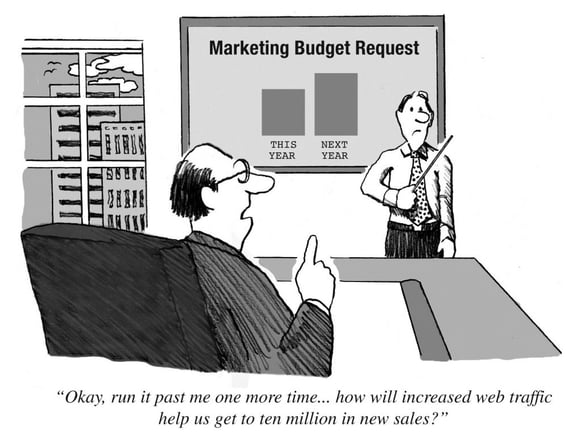Marketing is viewed by executives at logistics business as an expense, not an investment. To change this perception, marketing measurement must focus on sales results, not activities.

As our cartoon hints at, statistics that are unlikely to matter at the end of the day to C-level executives are things like:
- Web traffic
- Social likes and follows
- Ad impressions
- Keyword rankings
- Total inquiries (unless you can show the direct correlation to sales)
Not to say that YOU shouldn’t be measuring these things. After all, building an audience is an important means to the end you seek: sales results. But the boss doesn’t need to see everything you see.
By focusing your marketing measurement and executive reporting on how marketing activities impact sales achievement, you show the boss that you get it. That you understand why your position exists
If you don’t provide clear evidence of marketing’s ROI, come budget time these logistics CEOs will invest where they can gauge the return – in sales people to whom they can attach a sales quota.
Marketing Measurement: 4 Reports to Show to the Boss
To link marketing activities to sales, here are 4 reports you should show the boss every month – perhaps the ONLY reports.
- Percent of new sales revenue linked to a marketing generated lead. This can be a simple pie chart with a revenue value – typically the estimated annualized revenue that will be generated by this new account. This data, of course, requires that you have a CRM in place and are diligent about recording an accurate lead source. Make sure that marketing gets appropriate credit in this process. If a prospect calls into the sales line and a salesperson engages, that’s not a sales-generated lead. There must be clear alignment on how lead sources are assigned for marketing measurement.
- List of the new accounts, and their revenue, that were generated by marketing.
- Percent of the sales pipeline linked to a marketing generated lead. This can be a simple pie chart noting the estimated annual revenue of these potential customers. Many things, completely outside the control of marketing, determine whether a sales opportunity gets closed. This reports recognizes this and credits marketing for bringing qualified opportunities to the table, which is kind of our job, right?
- List of the new opportunities added to the pipeline in the last month that were generated by marketing.
That’s it. Four reports. Occasionally, you may want meet with the boss to show an analysis of how the numbers are trending over months and years.
But keep it focused on sales and you won’t be viewed as some marketing wonk talking about impressions, conversions, MQLs, SQLs and other terms that seem like a foreign language to the CEO.
But what if the results suck?
The answer is, you still show them. Otherwise you’re like Seinfeld’s George Costanza sitting in your closed office working on “the Penske file.” Eventually, someone will notice a certain lack of accountability.
And the numbers may not be as bad as you think. Before you start showing results, first define a baseline. If the baseline is monumentally poor, then your low numbers may still represent progress.
If your numbers don’t indicate progress, then that’s something everyone needs to know, including the boss. Leads that never turn into sales opportunities are probably not great leads, so you’ll want to examine your lead generating and nurturing tactics. Just like logistics operations, it’s about measurement and continuous improvement.
Moving the Needle
There are lots of needles that marketing activities can move. You should measure and track many of them.
But keep C-level reporting focused on one needle: the Sales needle. Do that and you’ll be seen as buttoned-up, results-oriented, and personally accountable.
Free eBook: Lead Generation for Logistics Services: Who's Job Is It, Anyway?







